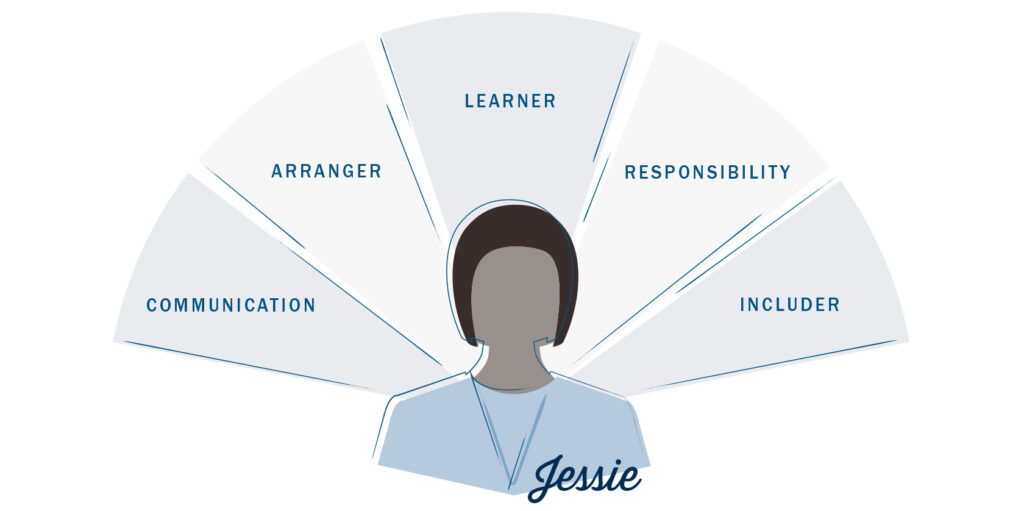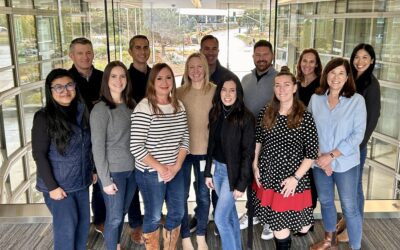Well, according to Peter Drucker, “It takes far less energy to move from first-rate performance to excellence than it does to move from incompetence to mediocrity.” Research has shown that the emphasis on weaknesses doesn’t provide the same level of impact as focusing on strengths. Leadership development firm Zenger Folkman studied 24,657 leaders who participated in 360-degree feedback assessments. The firm found that “regardless of how much effort [leaders] spent on correcting weaknesses, their efforts would only bring them to the midpoint on the overall measure of effectiveness.”
Let’s think about the activities we enjoy. For me, I love being in front of groups of people sharing ideas and learning from one another. I’ve always been comfortable in that space, but it has taken practice, education, observation, and time to hone my facilitation skills. While it wasn’t always easy, I loved the energy I got from developing my strength! When we give attention and focus to making our strengths even stronger, it adds to the energy that the strength already provides to our work.
Knowing your strengths at work and how to maximize their impact leads to enjoying work more, working with others more productively, and, ultimately, getting better results.
Figuring out our strengths
To empower this strengths-based approach, many organizations turn to the Gallup StrengthsFinder 2.0® assessment because of Gallup’s status as a leader in helping individuals and organizations bring strengths to work. However, the cool thing about focusing on strengths is that we’re not limited to just StrengthsFinder 2.0. There are many assessment tools available to identify areas of strength and energy that are ripe for professional development and increasing engagement.
No matter which assessment you take, knowing what to do next—what to do with your results—is usually the biggest question. What does it really take for individuals to build up their strengths and bring their best self to work?
As Gallup’s State of the American Workplace Report tells us, when an employee has the ability to showcase their best self on a regular basis, engagement increases and productivity goes up. Stronger individual performance leads to organizational benefits that, ultimately, carry over to clients and customers (heck yeah!).
Yet, according to Marcus Buckingham, co-author of Now, Discover Your Strengths, only two out of 10 individuals acknowledge being able to bring their best self at work. So, how do we influence this statistic in an upward direction? We can help individuals initiate momentum and realize their potential by encouraging them to learn, develop, leverage, and promote individual strengths.
To see what this approach looks like in action, I’d like you to meet Jessie. Jessie has recently transferred to a new division within her company. As part of her transition, Jessie’s team leader asked that she take the StrengthsFinder 2.0® assessment.

Her top five strengths at work are Communication, Arranger, Learner, Responsibility, and Includer. Jessie loves the idea of using her strengths in her new role, but she’s not quite sure how to go about doing that.
Learning about strengths
First, we want to help Jessie learn more about her strengths. Learning can take place in many forms. Since Learner is one of Jessie’s strengths, she decides to read the reports on each of her strengths to have a good initial overview. She also checks out the resources provided by Gallup for each of the 34 strengths.
To really learn about a personal strength is to understand how the context provided by the assessment company resonates to the individual. Questions an individual might ask include:
- Do I agree with the results?
- What about the results gives me energy and satisfaction?
- Do I recall how these strengths have helped me to succeed in the past?
Making connections with how she sees her strengths in action will help kick off how Jessie invests in, practices, and further develops her strengths at work.
Developing your strengths
Developing a strength is an investment in yourself. Just because you have a natural talent doesn’t mean it can’t use some extra polish to take you to the next level. For Jessie, having knowledge about what gives her energy and satisfaction allows her to stretch her muscles and develop her strengths.
Take her Communication strength—she is at ease sharing and articulating details to others. In her previous role, Jessie only had to share information in one-on-one situations. In her new role, she’ll need to develop her strength to be just as comfortable sharing information with larger groups. Lucky for her, each time she holds a team meeting she’ll be investing in and building up her Communication strength.
Be aware that each strength also has a shadow side. Any strength, when overused, may manifest itself as a potential weakness. For example, Jessie’s strength in Responsibility often causes her to overcommit to projects due to her sense of ownership and need to follow through on a promise.

We don’t want her to lose this work ethic, but her awareness of the shadow side to her Responsibility strength can help her identify when it is necessary to say no, delegate, or get others involved.
Leveraging strengths
So, what does it really mean to leverage a strength? To leverage means to use something to its maximum advantage. Once Jessie has some context and understanding for how her strengths benefit her, she can start thinking about how to use her strengths at work for maximum energy and impact. For example, Jessie leverages her Includer strength by inviting her new team to be involved as she learns about the team dynamics and builds relationships with her team members.
Leveraging your strengths requires a change in thinking. Keep in mind, though, that it doesn’t mean you should ignore what you’re not so good at! Think about how to change the perspective from “I’m not very good at that” to “How can I use my strengths to approach this situation differently?”
As leaders, it’s important that we help employees align their strengths with the expectations and responsibilities of their roles. In Jessie’s case, this will allow her to stretch her comfort zone and enhance her skills.
Promoting strengths in ourselves and others
Jessie knowing her strengths is just the first step. When all individuals throughout the organization are involved in learning, developing, and leveraging their strengths, it can exponentially increase engagement and productivity. Promote individual strengths by posting them in your work area for others to see. Keep the conversation going by talking with others to learn more about their strengths. This dialogue helps individuals see how their strengths can complement each other, balance weaknesses, or even contribute to conflict if not properly managed.
This strategy of promoting strengths works to Jessie’s advantage: she learns her coworker Terry has a high Achiever strength, which means he’s always motivated to accomplish things. Jessie partners with Terry, leveraging his drive to complete initiatives to help her implement new process flows she was considering for the team!
Strengthen those strengths
Shifting the paradigm from fixing weaknesses to building strengths takes no small amount of energy and attention. Yet, when organizations provide opportunities for employees to bring their best selves to work, everyone wins. Being intentional in supporting and promoting that shift can lead to higher employee engagement, productivity, and retention—all of which, ultimately, creates a stronger team and organization.
If you’d like to connect with our team to learn more about being a strengths-based organization, give us a call at 859-415-1000 or reach out through the form below.




